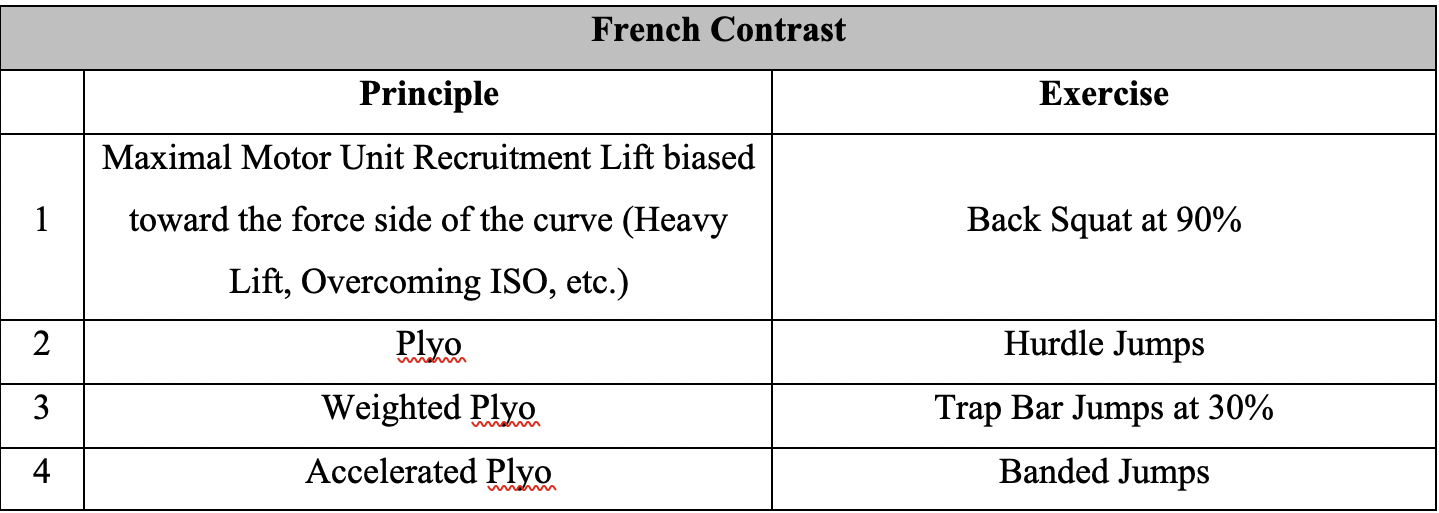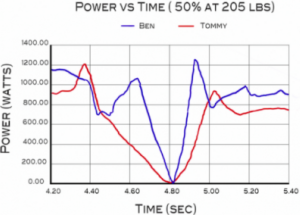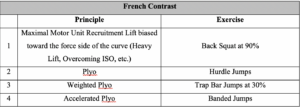
French Contrast Training and the Rotational Athlete
Today’s guest post comes from current Cressey Sports Performance – Florida intern, Chris Larrauri.
Athletes often ask coaches, “How does this relate to my sport?” And, my internship at Cressey Sport Performance – Florida was no exception; athletes want to know how the work they’re doing is going to transfer to baseball performance. Some athletes are adamant that everything they do should be specific to their sport, and although I wouldn’t stick to SPP (Specific Physical Preparation) year round, I believe that it is necessary to get as specific as we can in the weight room when the time calls for it. This is where a method like French Contrast comes into play.
French Contrast training has been a hot topic in the S&C field for quite some time. Invented by a former French track and field coach, Gilles Cometti, but widely popularized by one of my mentors, Cal Dietz, the French Contrast method has shown to increase explosive strength and speed endurance. Strength may be king, but sometimes it’s necessary to stimulate the organism to create a different training effect. It’s great to produce high amounts of force, but as we know the rate at which an athlete develops that force also matters. In baseball, this impulse could be the defining factor between a 89mph and 95mph pitch, or a weak ground ball and 400-foot homerun.

Figure 1.1 – Graphic showing the difference in rate of force development and overall power output. Ben’s impulse is higher causing more total power output. Graphic is from “Triphasic Training: A Systemic Approach to Elite Speed and Explosive Strength Performance”
If an athlete already has a great strength foundation, then methods such as the French Contrast can take them to the next level. Now, I know what you are thinking: “How are some jumps going to increase velocity on the mound?” My response is, “Does it have to be jumps?” I love jumping for various reasons, but when it’s time to transfer skill acquisition to the field of play, jumps aren’t all that specific to the rotational proficiencies baseball requires. There is a time and place for jumps with rotational athletes, but more during the GPP (General Physical Preparation) phase. For the SPP phase, let’s break down what French Contrast training is.
The French Contrast method is simple. It’s a combination of complex and contrast training. Complex training is a heavy compound lift (around 85% 1RM) followed by a plyometric that’s close to the same motor pattern. Contrast training is a maximal or near maximal compound lift paired with a “back-off” lift around 50-60% of the initial lift or something that mimics the initial lift’s motor pattern. In both situations, the heavy lift is causing a PAP (Post Activation Potentiation) effect for the subsequent movement. French Contrast put its own spin on these two methods to create its own stimulus. The sequence of French Contrast training is as follows:
When people think of French Contrast, they typically think of the basic exercise selection in the table above, but what if we apply the principles to focus more on the transverse and frontal planes instead of sagittal? I believe this can be a game changer for the rotational athlete.
Let’s take a look at what a plyometric is so we can better understand the principles behind French Contrast training and how we can apply them in different ways. Yuri Verkhoshansky created what’s known as the “Shock Method,” and later, an American named Fred Wilt pioneered the term “plyometric,” (plyo, for short) from Verkhoshansky’s research on the method. Fred’s interpretation of a plyo is “an overload of isometric-type muscle action which invokes the stretch reflex in muscle.” This is crucial because you can get this muscle action in other ways besides just jumping. Medicine balls are a great way to replicate this action. We can replace the jumps with, say, rotational medicine ball shotputs and scoop tosses to get an adaption that is more specific to the rotational athlete.
With this premise in place we can now put our attention toward exercise selection. Below are a few examples that can be used (you’ll rest 30 seconds between each exercise, but I’ve edited the videos to cut out the rest time) :
1. Split Squat Overcoming Iso (Maximal Effort): 7s/side
2. Rotational Med Ball Shotput (6lb): 3/side
3. Proteus Shotput (30% or 3-4RPE): 3/side
4. Accelerated Rotational Med Ball Shotput (6lb + band): 3/side
1. Landmine Lateral Lunge (85% 1RM w/070 Tempo): 1/side
2. Heiden (BW):3/side
3. Band-Resisted Heiden (BW+Band): 3/side
4. Accelerated Heiden (BW + Band): 3/side
1. 1-arm DB Bench Press w/Bridge (85% 1RM w/330 Tempo): 2/side
2. Med Ball Drop Chest Pass (6lb): x4
3. Rotational Landmine Press (30% or 3-4 RPE): 3/side
4. Accelerated Rotational Med Ball Shotput (6lb + band): 3/side
In conclusion, the principles of French Contrast can be manipulated to optimize transfer for almost any sport. That said, although this article may be covering how to adapt French Contrast training for different sports, I now understand that it may not be for every individual. So, you’ll need to assess the person in front of you to determine if it is appropriate or not. I will say that a nice discovery with using this method is that it’s not only effective, but also a lot of fun. And, if you come across an approach that safely delivers results while keeping athletes engaged, chances are that it deserves a place in your overall programming strategy.
References
Dietz, C. & Peterson, B. (2012) Triphasic Training: A Systematic Approach to Elite Speed and Explosive Strength Performance. By Dietz Sports Enterprise.
Verkhoshansky, Y. & Siff, M. (2009) Supertraining. Sixth Edition. Ultimate Athlete Concepts.
Verkhoshansky, Y. & Verkhoshansky, N. (2011) Special Strength Training Manual for Coaches. Verkhoshansky SSTM.
About the Author
Chris is a current intern at Cressey Sports Performance-Florida, where he works with baseball players at all levels ranging from professional to middle school. He assists in initial evaluations and exercise supervision. Prior experience to CSP includes time spent at the University of Minnesota under Cal Dietz; Jenks High School; Oklahoma Christian University; and as Owner of Synergy Performance. Chris graduated with a Bachelor’s Degree in Kinesiology from The University of Central Oklahoma. He is certified through the NSCA, PN-1, RPR & FRC. For more information, follow Chris on Instagram at @chris_larrauri.




